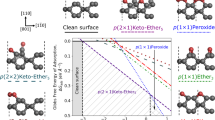Abstract
The surface functionalization of diamonds has been extensively studied through a variety of techniques, such as controlled oxidation. Several oxygen groups have been detected on oxidized diamonds, such as C–O–C (ester), C=O (ketonic), and C–OH (hydroxyl). However, the composition and relative concentration of these groups on diamond surfaces can be affected by the type of oxygenation treatment and the diamond surface quality. To investigate the stability of the oxygenated groups at specific diamond surfaces, we evaluated through fully atomistic reactive (ReaxFF force field) molecular mechanics (FARMM) simulations, the formation energies of the C=O, C–O–C, and C–OH groups on pristine and defective diamond surfaces (110), (111), and (311). According to our findings, the C–OH group has the lowest formation energy on a perfect (110) surface, while the C–O–C is favored on a defective surface. As for the (111) surface, the C–O–C group is the most stable for both pristine and defective surfaces. Similarly, C–O–C group is also the most stable one on the defective/perfect (311) surface. In this way, our results suggest that if, in a diamond film, the (110) surface is the major exposed facet, the most adsorbed oxygen group could be either C–OH or C–O–C, in which the C–O–C would depend on the level of surface defects.
Graphical abstract



Similar content being viewed by others
References
C. Li, X. Zhang, E.F. Oliveira et al., Carbon 182, 4977 (2021)
A.B. Putirath, E.F. Oliveira, G. Gao et al., Chem. Mater. 33, 4977 (2021)
C.T. van Duin, S. Dasgupta, F. Lorant, W.A. Goddard, J. Phys. Chem. A 105, 9396 (2001)
S. Zhao, K. Larsson, J. Phys. Chem. C 118, 1944 (2014)
J. Navas, D. Araujo, J.C. Piñero et al., Appl. Surf. Sci. 433, 408 (2018)
S.J. Sque, R. Jones, P.R. Briddon, Phys. Stat. Sol. A 202, 2091 (2005)
H. Tamura, H. Zhou, K. Sugisako et al., Phys. Rev. B 61, 11025 (2000)
K. Larsson, in Some Aspects of Diamonds in Scientific Research and High Technology, ed. by E. Lipatov (IntechOpen, London, 2019), https://www.intechopen.com/chapters/67682. Accessed 12 Feb 2022.
S.J. Plimpton, Comput. Phys. 117, 1 (1995)
S.J. Sque, R. Jones, P.R. Briddon, Phys. Status Solidi Appl. Mater. Sci. 11, 202 (2005)
P. Rivero, W. Shelton, V. Meunier, Carbon 110, 469 (2016)
M. De La Pierre, M. Bruno, C. Manfredotti et al., Mol. Phys. 112, 1030 (2014)
H. Kawarada, Surf. Sci. Rep. 26, 205 (1996)
E.F. Oliveira, M.R. Neupane, C. Li et al., Comput. Mater. Sci. 200, 110859 (2021)
Acknowledgments
The authors thank the Brazilian agencies CNPq and FAPESP (Grants 2013/08293-7, 2016/18499-0, and 2019/07157-9) for financial support. Computational support from the Center for Computational Engineering and Sciences at Unicamp through the FAPESP/CEPID Grant No. 2013/08293-7 and the Center for Scientific Computing (NCC/GridUNESP) of São Paulo State University (UNESP) is also acknowledged.
Author information
Authors and Affiliations
Corresponding author
Rights and permissions
About this article
Cite this article
Oliveira, E., Li, C., Zhang, X. et al. Stability of oxygenated groups on pristine and defective diamond surfaces. MRS Advances 7, 543–546 (2022). https://doi.org/10.1557/s43580-022-00242-1
Received:
Accepted:
Published:
Issue Date:
DOI: https://doi.org/10.1557/s43580-022-00242-1




